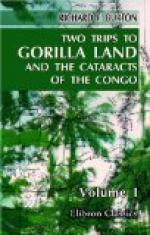Great would be my wonder if the West African as well as the East African Ghats did not prove auriferous; both fulfil all the required conditions, and both await actual discovery. The Mountains of the Moon, so frequently mentioned by M. du Chaillu and the Gaboon Mission, are doubtless the versants between the valleys of the Niger and the Congo. Lately Dr. Schweinfurth found an equatorial range which, stretching northwards towards the Bahr el Ghazal, was seen to trend westward. According to Mr. Consul Hutchinson ("Ten Years’ Wanderings among the Ethiopians,” p. 250), the Rev. Messrs. Mackey and Clemens, of the Corisco Mission “explored more than a hundred miles of country across the Sierra del Crystal Range of Mountains” —I am inclined to believe that a hundred miles from the coast was their furthest point. We shall presently travel towards this mysterious range, and there is no difficulty in passing it, except the utter want of a commercial road, and the wildness of tribes that have never sighted a traveller nor a civilized man.
The rivers of our region are of three kinds; little surface drains principally in the north; broad estuaries like the Mersey and many streams of Eastern Scotland in the central parts, and a single bed, the Ogobe, breaking through the subtending Ghats, and forming a huge lagoon-delta. Beginning at Camarones are the Boroa and Borba Waters, with the Rio de Campo, fifteen leagues further south; of these little is known, except that they fall into the Bight of Panari or Pannaria.
According to Barbot (iv. 9), the English charts give the name of Point Pan to a large deep bight in which lies the harbour-bay “Porto de Garapo” (Garapa, sugar-cane juice?); and he calls the two rounded hillocks, extending inland from Point Pan to the northern banks of the Rio de Campo, “Navia.” The un-African word Panari or Pannaria is probably a corruption of Pao de Nao, the bay north of Garapo, and “Navia.”
These small features are followed by the Rio de Sao Bento, improperly called in our charts the St. Benito, Bonito, Bonita, and Boneto; the native name is Lobei, and it traverses the Kombi country, —such is the extent of our information. The next is the well-known Muni, the Ntambounay of M. du Chaillu, generally called the Danger River, in old charts “Rio de Sao Joao,” and “Rio da Angra” (of the bight); an estuary which, like most of its kind, bifurcates above, and, receiving a number of little tributaries from the Sierra, forms a broad bed and empties itself through a mass of mangroves into the innermost north-eastern corner of Corisco Bay. This sag in the coast is formed by Ninje (Nenge the island?), or the Cabo de Sao Joao (Cape St. John) to the north, fronted south by a large square-headed block of land, whose point is called Cabo das Esteiras—of matting (Barbot’s Estyras), an article of trade in the olden time. The southern part receives the Munda (Moondah) river, a foul and unimportant stream, which has been occupied by the American missionaries.




